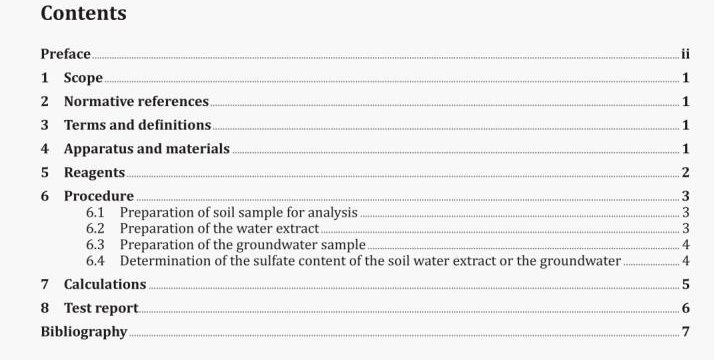Methods of testing soils for engineering purposes
AS 1289.4.2.1-2020 pdf download.Methods of testing soils for engineering purposes
Method 4.2.1: Soil chemical tests — Determination of the sulfate content of a natural soil and the sulfate content of the groundwater — Normal method.
6.1 Preparation of soil sample for analysis
The procedure shall be as follows:
(a) Dry the bulk sample prepared in accordance with the procedure specified in AS 1289.1.1 for the preparation oldisturbed samples for testing, in the oven at a temperature not exceeding 80 °C, and then cool.
NOTE Soils containing gypsum: Soils containing sulfates in the form of gypsum lose water on crystallization If heated above the specified temperature.
(b) Determine and record the mass (ni1) to the nearest 0.001 g of the sample.
(c) Crush all aggregations, other than discrete particles, and sieve over the 9.5 mm sieve.
NOTE Removal of gypsum lumps: it is assumed that any material retained on the 9.5 mm sieve will not contain sulfates. However, certain soils can contain lumps of gypsum larger than 9.5 mm diameter and, in such cases, the gypsum needs to be removed by hand, crushed to pass a 2.36 mm sieve, and incorporated in the fraction passing the 9.5 mm sieve.
(d) Reject the material retained on the 9.5 mm sieve and record the mass (m2) of material passing the sieve.
(e) Ensure there is no loss of fines through these steps and all subsequent operations.
(f) Divide the material passing the 9.5 mm sieve by successive riffling through the 13 mm divider or by quartering to produce a sample of approximately 100 g. Throughout this step and any subsequent operations, thoroughly mix the material available for any division and take precautions to avoid segregation during riffling.
(g) Pulverize this sample, so that it passes the 425 lim sieve, and then subdivide the sample by riffling through the 7 mm divider until a test portion of approximately 10 g is obtained.
(h) Place the test portion in the glass bottle and dry to constant mass in an oven at a temperature not less than 75 °C and not more than 80 °C.
NOTE Constant mass is considered to occur when the differences between successive mass determinations at intervals of 4 h do not exceed 0.1 % of the original mass (in1) of the sample.
6.2 Preparation of the water extract
The procedure shall be as follows:
(a) Remove the glass bottle containing the dried soil from the oven.
(b) Cool in the desiccator and determine its mass (m4).
NOTE Addition ofhydrochloricacid: Diluted hydrochloric acid may be used. hydrochloric acid is added to the soil extracts to destroy carbonates that would otherwise cause the subsequent precipitation of barium carbonate, and to increase the solubility of the sulfates in the soil. After addition of the acid it is advisable to wait for any effervescence to cease before proceeding with the extraction.
(1) Place the bottle and contents in the shaker and agitate for 30 mm.
(g) Filter the soil suspension through a suitable filter paper on the Buchner funnel using suction.
(h) Wash the extraction bottle and soil, transferring the washings to the glass filter funnel. NOTE Use offilter aids: With certain clayey soils It may be difficult to obtain a clear filtrate. In such cases the use of filter aids or centrifuging may be required.
(1) Transfer the extract to a 500 mL beaker.
(j) Rinse the filter flask (which takes the Buchner funnel) with distilled water and add to the beaker to make a total volume of approximately 250 mL.
6.3 Preparation of the groundwater sample
The procedure shall be as follows:
(a) Collect at least 500 mL of groundwater in a clean bottle Lsee Clause 4(c)] and filter through a suitable filter paper (Whatman No. 44 or similar).
NOTE Refer to AS/NZS 5667.11 for further methods for obtaining samples of groundwater.
(b) Remove 50 mL of the filtrate with a pipette and place in a 500 mL beaker.
(c) Add approximately 100 mL of distilled water and make the solution just acid to litmus, or indicator paper, by adding a few drops of hydrochloric acid.
NOTE Addition of hydrochloric acid: Diluted hydrochloric acid may be used. Hydrochloric acid is added to the soil extracts to destroy carbonates that would otherwise cause the subsequent precipitation of barium carbonate, and to increase the solubility of the sulfates in the soil. After addition of the acid it Is advisable to wait for any effervescence to cease before proceeding with the extraction.
6.4 Determination of the sulfate content of the soil water extract or the groundwater The procedure shall be as follows:
(a) Test the extract again with indicator paper and, if necessary, make just acid as in Clause 6.2 above.
(b) Bring extract to boiling point and add 25 mL of 5 % barium chloride solution, drop by drop, while stirring the solution. Keep the covered solution hot but not boiling for at least 1 h.AS 1289.4.2.1-2020 pdf download.
Methods of testing soils for engineering purposes
